Back in 2023, this article is dedicated to the women of our century. Those that you will meet during your stay in Peru and those that live daily in the city or in the countryside.
So vast is the territory that it is difficult to summarize the condition of the woman of Peru in a concise way without leaning on examples of different regions in order to present a diversity of profile of Peruvian women. According to the cities and the regions, their daily life also differs from the more or less urban environment in which they live. As an illustration, and for the pleasure of the eyes, the photographer Yayo Lopez took the time to make pictures and portraits to show the different facets of the Peruvian beauty.

Photo from the exhibition Belleza Peruana of La Galería del Centro Cultural de la Universidad de Lima
Some studies and statistics sadly announce Lima as one of the most dangerous cities of the world, in relation to the insecurities and violence made to the women, according to the report of the Convoca, organization of vigilance of Peru. The pandemic of the COVID-19 has accentuated the phenomenon, this year more than 915 women, of which 600 minors have disappeared only during the three months of confinement. These disappearances are often linked to acts of violence. At the end of 2020, there were 5,521 missing girls and adolescents, according to the Ministry of Women and Vulnerable Populations (MIMP). These statistics should be taken with caution as they reflect only part of the reality, since most rapes or sexual assaults, especially in rural or remote areas, go unreported. The difficulty for the authorities lies in the organization and handling of these complaints, as there is no national register of missing persons governed by the government, although this was requested in 2003. Peru does not have an official website to register this kind of cases, so it is the media and the social networks that try to do justice. But there again, the disinformation and the fact of relaying incomplete facts make the task difficult. We are therefore confronted with a structural problem, a lack of means and a lack of awareness of the problem at all levels.
It is necessary to say that the women come back from far, in particular under the regime of Fujimori, the president of Peru between the years 1996 and 2000, where campaigns of forced sterilizations were carried out within a framework of control of the birth rate. We count nearly 300 000 women, mainly from the Quechua indigenous regions, who would have been operated against their will and still present the after-effects today. Twenty years later, justice has not yet been rendered and these women still remain silent.
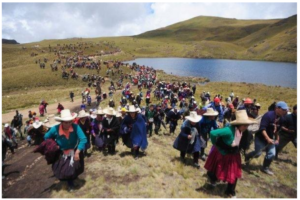
Woman of the high plateaux of the Andes
In the documentary “the belly of the women“, some agree to testify on all these atrocities, notably of the humiliation and the violence. This episode of the history leaves a bitter taste to all the community of defense of the rights of the women and the indigenous women. Let us recall that Fujimori is currently condemned to 25 years of prison but that its judgement for these sterilizations of force of is not completed.
As a world title, Peru is in third place in the world in terms of violence against women and feminicides. The problem is that the authorities often judge that it is the women who will be at the origin of the abuses and it is their behavior that justifies that their companions attack them. Traditions and religion have a particular impact on this phenomenon which leaves the daily life of Peruvian women still in a very gendered pattern. Let’s remember that abortion is not allowed in Peru, although the debate is often reopened. In a country where 83% of the inhabitants are catholic believers, the “pro-life” speeches are mostly relayed and the family represents a very important place.
However, women do not give in to this and violence against women is increasingly being brought to light. March 8th, the international day of women’s rights is the occasion
and is part of all feminist movements in South America, echoing the demonstrations in Argentina and Chile in 2010. The “luchadoras” (literally “those who struggle”) are in the protest marches or demonstrations, but it is a term that is used more for everyday life in reference to all those who have character and are always ready to manage to make their family survive with very limited means. One of the ways for Peruvian women to emancipate themselves professionally and personally are the collectives of women entrepreneurs, notably the associations of crafts, fashion or cosmetics. To this is often coupled an ecological and sustainable dimension to be part of a dynamic local economy.
Peru will not be described as a “machist” country, at least not as much as Brazil, Spain or Italy. However, we can see that in the daily life, the roles are still very gendered as well within the home as in the professional life.
« Mamita », « casera », « mamacita linda »
On a daily basis, we can hear these nicknames very often, emotional nicknames but which illustrate the place that women have in the collective imagination, at the same time a wife, a mother, a sister, a cousin. In tourism, the third largest sector in Peru, women are at the forefront of many professions: from the hostess who welcomes you at the airport, to the receptionist at your hotel, to the local restaurant where you will eat, to the family where you can experience a night in the home, these are women you will meet. The transportation and guiding sectors are still predominantly done by men. It is always with great involvement and efficiency that the tasks are carried out, and this with a very wide range of hours.
The historian Rosi Villanueva will say that the “Peruvian woman manages her company or her trade in the same way as her home or her family”, there is thus a great emotional part which will be implied in the canvassing and the construction of the project. Attempts to highlight women’s work are emerging, but this is still a very traditional pattern and women’s “little hands” are often used without being valued.
If you have the opportunity to stay in a home, the “casas vivenciales” – and we strongly encourage you to do so – you will also be able to observe the phenomenon of women running the house, doing the housework, cooking, maintenance and organization in general. You will not be disappointed with the recipe for quinoa soup that is passed down from mother to daughter. The transmission of traditions and more particularly, from mother to daughter is very important, for the weaving, the young people have a succession of patterns to learn before their fourteenth birthday, in order to mark the passage from adolescence to adulthood.

Photo of a woman in front of her loom in Chinchero
Because they also stay at home more often, their level of Spanish is generally lower than that of men, who are more often outside and therefore more inclined to meet new people and practice a second language, in addition to Quechua or Aymara. In the Andes, Spanish is now used for all exchanges and business, even in the most remote communities, where, thanks to national and international funds, schools are being built. A help, which allows both boys and girls to obtain the basics in order to read and write, in Quechua and Spanish.
In order to introduce you to the women who have a direct impact on your trip to Peru, here is this section “Portrait of women”, which presents those with whom we work and who will know how to welcome you and make you share their daily life with immense generosity. Thank you to them for their work, their involvement in the promotion of sustainable and responsible tourism.
Portrait of women:
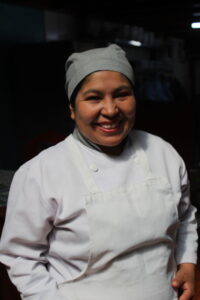
Selia : Talented cook, Selia was fired from the big restaurants of Cusco when she got pregnant. Never having given up, she then set up her small restaurant where we had been eating regularly for a few years. While the crisis has hit her hard as for many restaurant owners, we have set up with her a new option of cooking classes that we propose in our itineraries. An option allowing you to meet her, to learn to cook like a chef and to share a superb half-day in her company.
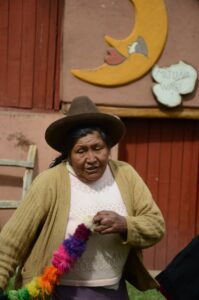
Natividad : Receiving tourists on the Huchuy Qosqo trek, Natividad was one of the first to develop a community tourism initiative near the archaeological complex of Little Cusco in the Sacred Valley. While her husband Silverio is often in the fields, it is she who receives and pampers our groups for years in her colorful house. Excellent cook, Natividad always prepares us pleasant small dishes at our arrival at her home. Smiling and dynamic, she also likes to sing and dance with her guests.

Julia : Living in the heart of the coffee and cocoa plantations, Julia has also been receiving us for years in her house in Huayopata. An agricultural engineer by profession, Julia is a true bible for all those who have the chance to share a day with her. Loving to share her knowledge with her guests, Julia always takes us to the heart of her coffee and cocoa plantations, fruit trees and medicinal plants, offering us each time memorable botanical lessons.
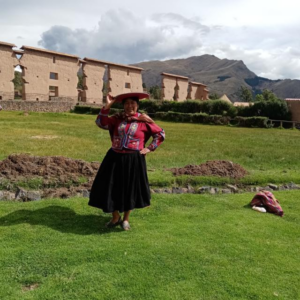
Esther : Esther is the president of the Raqchi Tourist Association and has been an important partner of the agency for many years. In addition to receiving our clients like royalty, Esther also teaches them the art of ceramics and offers them the opportunity to discover the costumes, festivals and traditions of the region. Before the covid, her role in the community allowed her to organize larger meetings and sharing moments with all the women of Raqchi. Because of the pandemic, Esther told us that for the moment visits and sharing can only be done with her and her immediate family. Perhaps things will return to normal in the future.
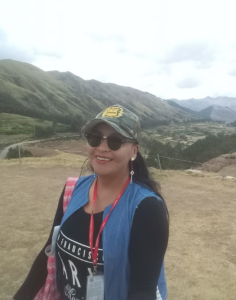
Rosa Maria : Originally from Arequipa and having grown up on the shores of Lake Titicaca, Rosa Maria is a tourist guide and specialist in anthropology. It is difficult to find a person who knows better the history and traditions of the civilizations of the highest navigable lake in the world. Considering each of the groups that we entrust to her as “her children”, Rosa Maria is a true entertainer with whom we have worked for many years now.
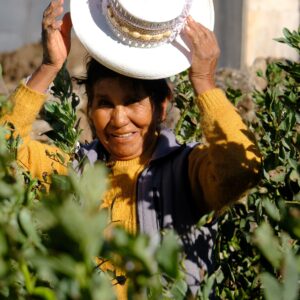
Julia – Canocota : Living in the Colca in the small village of Canocota, Julia is a bit of a grandmother to us all at Pasion Andina. It is with great pleasure that we go to her house every year with our clients. Like Natividad in Huchuy Qosqo, Pedro and Julia were the first to launch a turismo vivencial initiative in Canocota. While her husband Pedro unfortunately left us a few years ago, Julia is now the sole owner of her charming little house. An excellent cook, Julia also always teaches us about the medicinal properties of the different plants of the region during shared experiences in the fields. She is also a talkative person and enjoys telling local myths and legends to people who stay at her house.
Once again, we remind you that Peru is a very big country, so it is necessary not to make generalities about the condition of women in relation to the daily life of the women of the capital of Lima or the women living in the Andes, the reality is much more complex and is not fixed. One thing is sure, women have not finished their way towards emancipation in comparison with other western countries, however the daily life is improving. The Peruvian State must take the necessary measures for the protection and security of Peruvian women in order to reduce its aggressions and violence. Carried by complete and inspiring female figures, like the women of power of ancient Peru, or activists, warriors, artists, researchers, scientists from the 19th century, the young Peruvian women have true models to continue to create the fame of Peru, in small or large scale.
We thank you for following this series of articles and hope you enjoyed this format.
To learn more about the history of Peru and its cultural themes, as well as to make a trip to Peru, do not hesitate to contact us.
————————————————————————————————————————————–
Sources for all the articles in the series “Women of Peru” :
Youtube, TeleSUR English, “More Than 900 Women Disappeared In Peru During The Quarantine”
https://www.youtube.com/watch?v=4tLmFvqisHY
Information TV5 Monde, “More Than 900 Women Disappeared In Peru During The Quarantine”.
https://information.tv5monde.com/terriennes/au-perou-pres-d-un-millier-de-femmes-ont-disparu-pendant-le-confinement-369781
Democracy Magazine, “Interview with Zuliana Lainez, Time for Women in Peru”.
Information TV5 Monde, “Peru through its forgotten women writers of the History”.
Information TV5 Monde, “Forced sterilization in Peru: Alberto Fujimori in front of the justice, a trial for the history”
Information TV5 Monde, “In Peru, 300 000 women sterilized by force”.
https://information.tv5monde.com/terriennes/au-perou-300-000-femmes-sterilisees-de-force-3332
Una pizca de Cine, Musica, Historia y Arte, “Chabuca Granda
https://unapizcadecmha.blogspot.com/2013/03/chabuca-granda.html
Arequipa Tradicional, “La Monja Gutierrez
https://arequipatradicional2.blogspot.com/2020/03/la-monja-gutierrez.html
The small newspaper, Women in the process of independence of Peru
https://lepetitjournal.com/lima/vivre-lima/femmes-independance-perou-317459
Palos al Viento, “La mujer en la historia piurana y peruana
http://palosalviento.blogspot.com/2015/11/la-mujer-en-la-historia-piurana-y.html
Sara Beatriz Guardia, “Tres mujeres en la construcción de la República: Dominga Gutiérrez, Francisca Zubiaga y Flora Tristán”
Armando Guevara Gil, “Entre la libertad y los votos perpetuos: el caso de la monja Dominga Gutiérrez (Arequipa, 1831)”
Pierre Luc Abramson, “Flora Tristan and the Peruvian politics”.
Click to access Flora-Tristan-et-la-politique-p%C3%A9ruvienne.pdf
Convoca, “Covid-19: ¿A quién le importa las 915 peruanas desaparecidas durante la cuarentena?”
Metrica, “Las 20 mujeres más influyentes en la historia del Perú”
Sitio web del districto de Miraflores, “Chabuca Granda: la compositora peruana más universal”
https://www.miraflores.gob.pe/chabuca-granda-la-compositora-peruana-mas-universal/
Las Capullanas
Guaman Poma, Nueva corónica y buen gobierno (1615), “LA PRIMERA COIA
Maritza Villavicencio, “Woman, power and food in ancient Peru” (2017)
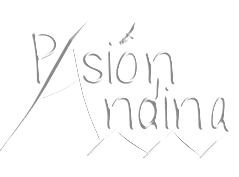

Comments